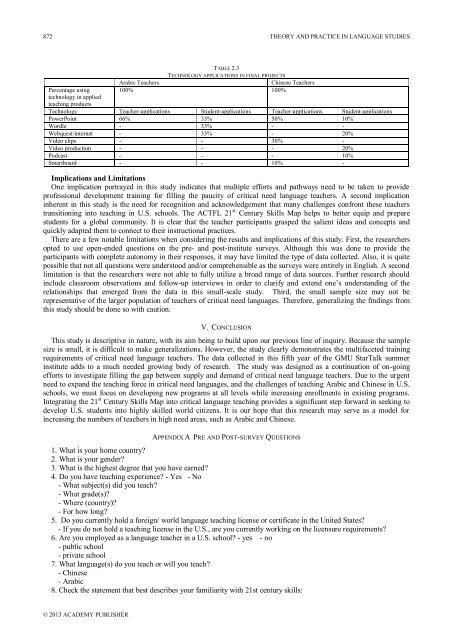Theory and Practice in Language Studies Contents - Academy ...
Theory and Practice in Language Studies Contents - Academy ...
Theory and Practice in Language Studies Contents - Academy ...
You also want an ePaper? Increase the reach of your titles
YUMPU automatically turns print PDFs into web optimized ePapers that Google loves.
872 THEORY AND PRACTICE IN LANGUAGE STUDIESPercentage us<strong>in</strong>gtechnology <strong>in</strong> appliedteach<strong>in</strong>g productsTABLE 2.3TECHNOLOGY APPLICATIONS IN FINAL PROJECTSArabic TeachersCh<strong>in</strong>ese Teachers100% 100%Technology Teacher-applications Student-applications Teacher-applications Student-applicationsPowerPo<strong>in</strong>t 66% 33% 50% 10%Wordle - 33% - -Webquest/<strong>in</strong>ternet - 33% - 20%Video clips - - 30% -Video production - - - 20%Podcast - - - 10%Smartboard - - 10% -Implications <strong>and</strong> LimitationsOne implication portrayed <strong>in</strong> this study <strong>in</strong>dicates that multiple efforts <strong>and</strong> pathways need to be taken to provideprofessional development tra<strong>in</strong><strong>in</strong>g for fill<strong>in</strong>g the paucity of critical need language teachers. A second implication<strong>in</strong>herent <strong>in</strong> this study is the need for recognition <strong>and</strong> acknowledgement that many challenges confront these teacherstransition<strong>in</strong>g <strong>in</strong>to teach<strong>in</strong>g <strong>in</strong> U.S. schools. The ACTFL 21 st Century Skills Map helps to better equip <strong>and</strong> preparestudents for a global community. It is clear that the teacher participants grasped the salient ideas <strong>and</strong> concepts <strong>and</strong>quickly adapted them to connect to their <strong>in</strong>structional practices.There are a few notable limitations when consider<strong>in</strong>g the results <strong>and</strong> implications of this study. First, the researchersopted to use open-ended questions on the pre- <strong>and</strong> post-<strong>in</strong>stitute surveys. Although this was done to provide theparticipants with complete autonomy <strong>in</strong> their responses, it may have limited the type of data collected. Also, it is quitepossible that not all questions were understood <strong>and</strong>/or comprehensible as the surveys were entirely <strong>in</strong> English. A secondlimitation is that the researchers were not able to fully utilize a broad range of data sources. Further research should<strong>in</strong>clude classroom observations <strong>and</strong> follow-up <strong>in</strong>terviews <strong>in</strong> order to clarify <strong>and</strong> extend one’s underst<strong>and</strong><strong>in</strong>g of therelationships that emerged from the data <strong>in</strong> this small-scale study. Third, the small sample size may not berepresentative of the larger population of teachers of critical need languages. Therefore, generaliz<strong>in</strong>g the f<strong>in</strong>d<strong>in</strong>gs fromthis study should be done so with caution.V. CONCLUSIONThis study is descriptive <strong>in</strong> nature, with its aim be<strong>in</strong>g to build upon our previous l<strong>in</strong>e of <strong>in</strong>quiry. Because the samplesize is small, it is difficult to make generalizations. However, the study clearly demonstrates the multifaceted tra<strong>in</strong><strong>in</strong>grequirements of critical need language teachers. The data collected <strong>in</strong> this fifth year of the GMU StarTalk summer<strong>in</strong>stitute adds to a much needed grow<strong>in</strong>g body of research. The study was designed as a cont<strong>in</strong>uation of on-go<strong>in</strong>gefforts to <strong>in</strong>vestigate fill<strong>in</strong>g the gap between supply <strong>and</strong> dem<strong>and</strong> of critical need language teachers. Due to the urgentneed to exp<strong>and</strong> the teach<strong>in</strong>g force <strong>in</strong> critical need languages, <strong>and</strong> the challenges of teach<strong>in</strong>g Arabic <strong>and</strong> Ch<strong>in</strong>ese <strong>in</strong> U.S.schools, we must focus on develop<strong>in</strong>g new programs at all levels while <strong>in</strong>creas<strong>in</strong>g enrollments <strong>in</strong> exist<strong>in</strong>g programs.Integrat<strong>in</strong>g the 21 st Century Skills Map <strong>in</strong>to critical language teach<strong>in</strong>g provides a significant step forward <strong>in</strong> seek<strong>in</strong>g todevelop U.S. students <strong>in</strong>to highly skilled world citizens. It is our hope that this research may serve as a model for<strong>in</strong>creas<strong>in</strong>g the numbers of teachers <strong>in</strong> high need areas, such as Arabic <strong>and</strong> Ch<strong>in</strong>ese.APPENDIX A PRE AND POST-SURVEY QUESTIONS1. What is your home country?2. What is your gender?3. What is the highest degree that you have earned?4. Do you have teach<strong>in</strong>g experience? - Yes - No- What subject(s) did you teach?- What grade(s)?- Where (country)?- For how long?5. Do you currently hold a foreign/ world language teach<strong>in</strong>g license or certificate <strong>in</strong> the United States?- If you do not hold a teach<strong>in</strong>g license <strong>in</strong> the U.S., are you currently work<strong>in</strong>g on the licensure requirements?6. Are you employed as a language teacher <strong>in</strong> a U.S. school? - yes - no- public school- private school7. What language(s) do you teach or will you teach?- Ch<strong>in</strong>ese- Arabic8. Check the statement that best describes your familiarity with 21st century skills:© 2013 ACADEMY PUBLISHER
















